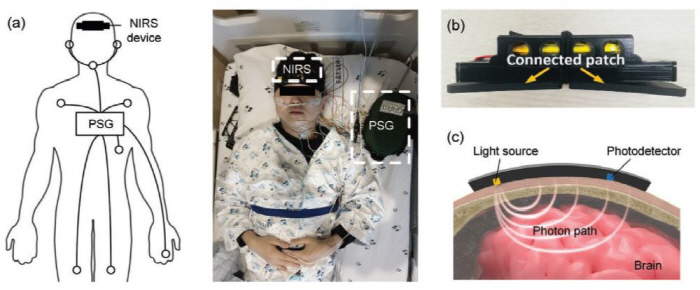Development of brain cleaning and real-time measurement technology during sleep to prevent dementia for the first time in the world
Jul 23, 2025
|
A joint research team led by Professor Yoon Chang-ho of the Department of Neurology at Seoul National University Bundang Hospital and Professor Bae Hyun-min of the Department of Electrical and Electronic Engineering at KAIST announced that they have developed a non-invasive test method based on Near Infrared Spectroscopy (NIRS) that can monitor the activities of the brain waste discharge system during sleep for the first time in the world.
When a person falls asleep, the cerebrospinal fluid surrounding the brain seeps deep into the brain along the space around the blood vessels to wash away waste, and is discharged through the meninges lymphatic system or cervical lymph nodes.
The system in which cerebrospinal fluid enters the brain during sleep, cleans brain tissue, and exits is called 'glia wave system', and amyloid beta is a typical waste product cleaned through this. Long-term accumulation in the brain is well known to damage nerve cells and cause Alzheimer's disease.
In other words, the glial system is one of the key functions of sleep and the cranial nervous system protection mechanism that suppresses degenerative brain diseases such as dementia and Parkinson's disease by removing these wastes.
However, until now, there has been a limit to real-time non-invasive observation of how the glial wave system works during sleep in the human body. MRI has the burden of administering intracranial contrast agents, and cannot be performed continuously for the entire sleep time ranging from 7-8 hours, and it is difficult to quantify the results.
Accordingly, the research team conducted a study to develop a technology that can non-invasive and continuous measurement of glial wave activity in humans during the entire sleep time and succeeded in real-time measurement of fluid flow in the brain using a 'wireless near-infrared spectrometer' that is sensitive to moisture changes.
The wireless near-infrared spectrometer developed by the research team operates attached to the forehead and transmits near-infrared rays with a wavelength of 700-1,000 nanometers (nm) into the skull, and analyzes the absorption rate of scattered light to calculate brain moisture, oxygen saturation, and blood flow. In particular, it is used centering on the moisture-sensitive 925nm wavelength, and an algorithm that removes the effect of cerebral blood flow (plasma moisture) from the measured moisture content can be precisely evaluated.
The research team conducted a verification study on 41 healthy adults using the equipment and confirmed that the amount of water in the frontal lobe increased significantly during the process of falling asleep in arousal and progressing to non-REM sleep (NREM). This is a result showing that brain washing activity becomes more active toward the deep sleep stage, consistent with the pattern of glial wave activity observed in animal experiments.
In addition, moisture content increased the most in the first deep sleep cycle after falling asleep, suggesting that the early stages of sleep are a key time zone for brain cleaning activities, which is expected to be an important reference for establishing guidelines for future sleep treatment.
The study is the world's first to develop a base technology that continuously measures brain moisture during the entire sleep time in humans to quantify glial wave activity in real time, and it is drawing attention as a major turning point in scientifically identifying the link between sleep and dementia.
In addition, the equipment is developed in a wireless non-invasive manner and is likely to expand into wearable equipment for home brain health monitoring in the future.
Professor Yoon Chang-ho predicted, "This study is meaningful in that it has developed the world's first near-infrared spectroscopy-based technology that can quantitatively assess the activity of the glia-wave system during sleep and laid the foundation for scientifically identifying the link between sleep and brain health." "It can be widely used to evaluate the effectiveness of sleep treatment and establish personalized brain health management strategies."
Meanwhile, the findings were published in the official journal of the International Society of Cerebral Blood Flow and Metabolism.
|
|
This article was translated by Naver AI translator.
















